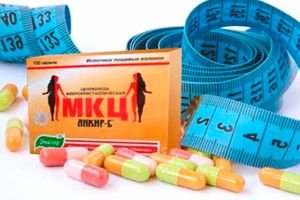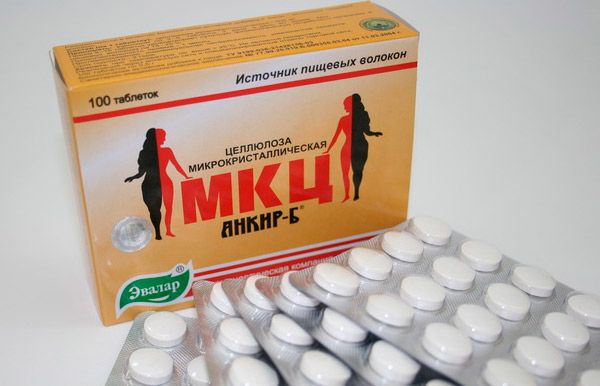
All iLive content is medically reviewed or fact checked to ensure as much factual accuracy as possible.
We have strict sourcing guidelines and only link to reputable media sites, academic research institutions and, whenever possible, medically peer reviewed studies. Note that the numbers in parentheses ([1], [2], etc.) are clickable links to these studies.
If you feel that any of our content is inaccurate, out-of-date, or otherwise questionable, please select it and press Ctrl + Enter.
MCC for weight loss
Medical expert of the article
Last reviewed: 03.07.2025

Dietary supplement with microcrystalline cellulose - MCC for weight loss (MCC Ankir B, MCC diet) - should reduce appetite and, thus, significantly reduce the amount of food consumed, an excess of which most often leads to obesity.
 [ 1 ]
[ 1 ]
ATC classification
Active ingredients
Pharmacological group
Pharmachologic effect
Indications MCC for weight loss
Thus, the indications for the use of the MCC supplement for weight loss are weight loss. In addition, this product promises not only to speed up the process of food passage through the gastrointestinal tract, but also to cleanse the body of metabolic products and accumulated toxins.
The instructions for the MCC dietary supplement indicate such indications for its use as digestive problems, constipation, intestinal microflora disorders, gastrointestinal diseases, high cholesterol or blood sugar levels, bacterial intoxication of the body, and poisoning with heavy metal salts. Manufacturers of various modifications of MCC for weight loss also recommend taking the supplement for preventive purposes: to prevent the development of atherosclerosis, heart ischemia, cholelithiasis, nephrolithiasis (formation of kidney stones), and cancer.
Pharmacodynamics
Although MCC for weight loss does not belong to anorexigenic drugs, the mechanism of action of the dietary supplement requires clarification (which is not included in the instructions for their use). In the descriptions of MCC, it is noted that the pharmacological action of this product is to replenish the lack of dietary fiber.
The active component of MCC for weight loss is microcrystalline cellulose (fiber) - a food additive E 460 widely used in the food and pharmaceutical industries, which is a structure modifier that prevents products from sticking together and caking.
From a chemical point of view, cotton cellulose is an inert substance - water-insoluble structural polysaccharides. It is polymerized glucose, which supports the cell membranes of the plant by combining linear macromolecules into a crystalline structure. There are no enzymes in human gastric juice that can digest cellulose.
Cotton cellulose is obtained in the process of cotton processing - from its purified fluff (lint). By subjecting the macromolecules of the fibers to destruction, microcellulose with increased hydrophilicity is obtained - due to an increase in the permeability area for hydration. This is the basis for the pharmacodynamics of MCC for weight loss.
Swelling in the stomach and increasing in volume, microcellulose, like ballast, creates the illusion of food intake and satiety (the feeling of hunger decreases or disappears for a while), but this substance has no nutritional value, since it is not digested in the stomach and is not absorbed in the small intestine. In addition, acting as an enterosorbent, MCC absorbs many substances in the intestine, including cholesterol, which gets there from the gallbladder.
Pharmacokinetics
Since the fiber included in MCC for weight loss is an insoluble polysaccharide, its fibers are not broken down into monosaccharides by digestive enzymes in the stomach, but pass through the entire gastrointestinal tract without being metabolized.
In various parts of the large intestine, hydrolysis of some of the fibers occurs by obligate bacteria of the intestinal microbiota. Microcellulose is excreted from the body with feces.
Dosing and administration
MCC tablets for weight loss are taken 20-25 minutes before meals; the tablets should be crushed to a powder state, mixed with a spoonful of water and taken orally, always with a glass of liquid.
During the first week, 5 tablets are taken three times a day; during the second and third weeks, 10 tablets three times a day. Then, during the fourth week, the number of tablets per dose is reduced to 3-5. The duration of use is 4 weeks, repeated courses can be carried out with 15-day breaks.
The maximum daily dose of dietary supplements with microcrystalline cellulose is 45 tablets (15 tablets three times a day). To avoid constipation, the daily water intake should be increased to 2-2.5 liters.
Use MCC for weight loss during pregnancy
The use of MCC for weight loss during pregnancy and lactation is contraindicated.
Side effects MCC for weight loss
Side effects that may be caused by the use of MCC include: discomfort and heaviness in the stomach, constipation, general weakness, exacerbation of gastrointestinal diseases, vitamin deficiency (due to the removal of vitamins and iron from the body), deterioration of the skin condition (as a result of the removal of zinc), increased bone fragility (due to a decrease in calcium and phosphorus).
 [ 13 ]
[ 13 ]
Overdose
Overdose of MCC is not covered in the description of the product; information regarding interaction with other drugs is also absent.
Judging by the reviews that can be found from doctors about the effectiveness and safety of losing extra pounds with the help of MCC for weight loss, this remedy should be used only after medical consultation with a good specialist in dietary nutrition, as well as with a simultaneous revision of your diet - both in terms of its composition and the amount of food consumed.
And the reviews of those who lost weight alternate with reviews of those who either failed to achieve the desired result, or the 3-4 kilograms they lost returned rather quickly. As eloquently evidenced by the phrase "MCC for weight loss did not help several times."
Attention!
To simplify the perception of information, this instruction for use of the drug "MCC for weight loss" translated and presented in a special form on the basis of the official instructions for medical use of the drug. Before use read the annotation that came directly to medicines.
Description provided for informational purposes and is not a guide to self-healing. The need for this drug, the purpose of the treatment regimen, methods and dose of the drug is determined solely by the attending physician. Self-medication is dangerous for your health.


